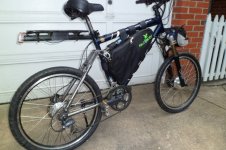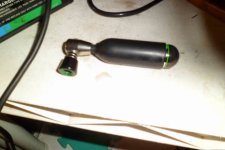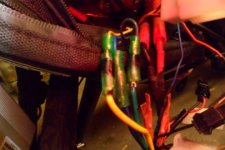motomech
10 MW
I put this in this section because, as far as I know, this is the first documented 2WD install using the "328" "fast wind" mini-motors and one of the initial test results is a little suprising to me. But it shouldn't have been as the Ebike CA's simulator had predicted it.
But first, the install, which consisted of two Ananda Q100 36V 328 motors. These kits come with a very small 15A KU63 controllers. Except for exchanging the main battery to controller connectors to 4 mm bullets, the kits were installed "as supplied' and not modified.
Both kits were very easy to install. The 9-speed DNP free wheel fit in the standard drop-out with a plain washer inside the chain stay on each side.
The rear disc. lined up without drama, but the rim was slightly off center. As supplied, it needed truing and a spoke adjustment, so I combined those two operations with a bit of "dishing"[a misnomer here, as I only moved it over a few milimeters].
The frt. kit was, if anything, even easier to install. The wheel was ok out of the box and I had already clearanced[filed]the drop outs to fit a MXUS geared motor.
Fitting the mini- motor's 12 mm axle does not require 'deepening" the drop-out to center the axle as does a 14 mm axle. Only a small amount of widening and contouring to match the half-round portion of the axle. With the correct size round file, a few passes is all that is needed.;
The only change to the platform is the substitution of the original 26" wheels for a pair of 24 inchers. This is a large framed bike and with my 29" inseam, I always felt as if I was riding a step ladder.


But first, the install, which consisted of two Ananda Q100 36V 328 motors. These kits come with a very small 15A KU63 controllers. Except for exchanging the main battery to controller connectors to 4 mm bullets, the kits were installed "as supplied' and not modified.
Both kits were very easy to install. The 9-speed DNP free wheel fit in the standard drop-out with a plain washer inside the chain stay on each side.
The rear disc. lined up without drama, but the rim was slightly off center. As supplied, it needed truing and a spoke adjustment, so I combined those two operations with a bit of "dishing"[a misnomer here, as I only moved it over a few milimeters].
The frt. kit was, if anything, even easier to install. The wheel was ok out of the box and I had already clearanced[filed]the drop outs to fit a MXUS geared motor.
Fitting the mini- motor's 12 mm axle does not require 'deepening" the drop-out to center the axle as does a 14 mm axle. Only a small amount of widening and contouring to match the half-round portion of the axle. With the correct size round file, a few passes is all that is needed.;
The only change to the platform is the substitution of the original 26" wheels for a pair of 24 inchers. This is a large framed bike and with my 29" inseam, I always felt as if I was riding a step ladder.






